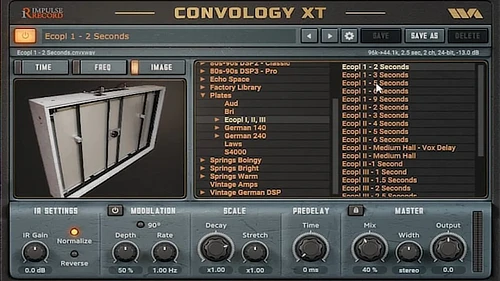Back in the day, any guitarist worth his salt had a Roland RE-201 Space Echo. It was used on stages and in recording studios all over the world, and today is emulated in pedals by just about everyone.
Front-panel controls included repeat rate (echo length), intensity (number of echo repeats), and separate levels for echo and reverb. Bass and treble controls provided EQ for the effect sound. The front panel also offered inputs for multiple sound sources, including two mics and an instrument (all with independent level controls), and a line-level device such as a mixer.
Lifting the hinged lid on top of the Roland RE-201 exposed the heart of the machine, its tape transport system. Featuring a record head, three separate playback heads, and a variable speed motor, the Roland RE-201 was capable of producing a unique range of echo effects. The delay time was adjusted by altering the tape’s speed with the Repeat Rate knob, along with selecting one or more playback heads with the Mode Selector (multi-tap echo patterns were created when multiple heads were selected).
Along with the built-in spring reverb and the ability to feed the delayed sound back into the record head for multiple echo repeats, this allowed for a combination of echo effects previously unavailable in any single portable device.
A unique feature of the Roland RE-201’s tape transport was its free-floating design. The single tape loop spooled freely into a tape chamber, with a plastic cover over the top to protect the tape. Previous designs used short tape loops spun over reels, like a miniature reel-to-reel tape recorder. The RE’s loose-spool, low-tension design created less tape wear, and also allowed for a much longer tape length; this long tape length let you create echoes over three seconds in length.
The Roland RE-201 was an instant hit, quickly becoming the tape echo of choice for musicians both on the road and in the studio. Its rich and organic sound was a source of inspiration and creativity, and it’s been heard on literally thousands of popular records since its introduction. It wasn’t always used for straight echo effects, either – by manipulating the tape speed and intensity while signal was present, you could coax a Space Echo into oscillation and pitch shift for some unreal sound effects.
On the heels of the Roland RE-201’s popularity, enhanced RE-series models were released over the years. 1977’s RE-301 added Roland’s famous chorus effect, as well as sound-on-sound recording capability. 1980 saw the introduction of two additional units: the RE-501, which added XLR inputs to the RE-301’s feature set, and the SRE-555, which was basically an RE-501 in a rackmount chassis. However, nothing matches the Roland RE-201 for its legendary status.
Features
- Practical 3-channel Input Control The RE-201 is equipped with independent three channel input controls – two for microphones and one for instruments – and produce high quality sounds when these inputs are mixed using level meter and peak level pilot lamp. Also, in instrument channel, echo effect on instrument sound can be cancelled with the echo/normal changeover switch. This is convenient when a microphone is used with instruments.
- Rich Variation of Echo Sounds The RE-201, 12 modes including reverb effect. These modes are further varied by the repeat rate, intensity and echo volume controls for rich echo sound variation. In the RE-201, echo sound tone can be freely adjusted by the treble and bass controls without influencing original sound. The incorporates made by the O.C.E. in a reverb unit clear reverberation effect U.S.A. to add to echo effect.
- Well-developed Mechanism with Minimal Wow & Flutter and Low Noise Free running system (tape runs freely in the case and appropriate length and rotation of endless tape are maintained) is employed for tape running unit. Newly engineered heads and running unit, direct drive type brushless electronic servo motor, and quality endless tape “RT-I ” keep wow and flutter and noise at a minimum. Thus, best echo sound is always obtainable. Furthermore, tape life is greatly prolonged to 400 hours, 10 to 20-fold, compared with conventional echo chambers, and during this time, quality of the tape is maintained.







